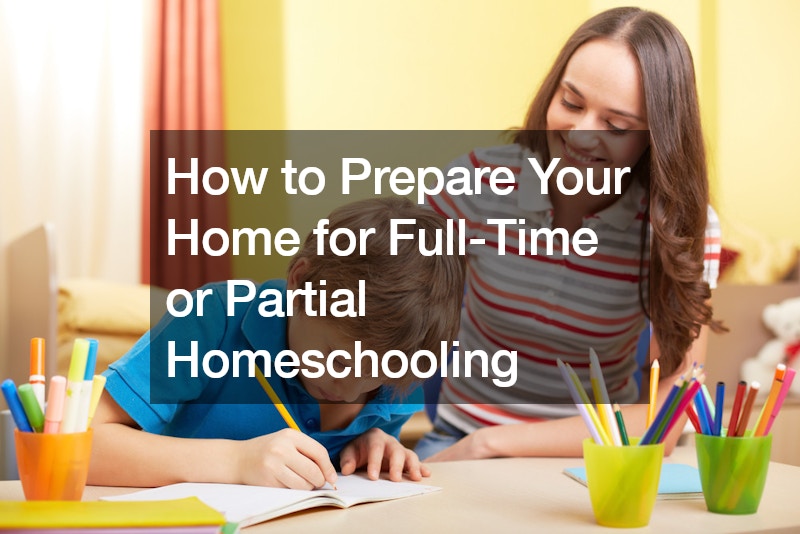
Homeschooling, whether full-time or partial, represents a significant educational shift for families. It’s a choice driven by various factors: from seeking academic flexibility and personalized attention to addressing special learning needs or preferences that traditional schooling might not accommodate. For many parents, the decision to homeschool is not just about educational philosophy but also about practical considerations such as schedule flexibility and family dynamics. This decision is also driven by how many more resources, communities, and otherwise are available these days than in the past.
Creating an effective homeschooling environment goes beyond setting up a designated study area. It involves thoughtful planning and adaptation of your home space to serve dual purposes: as a living space and as a place of learning. This dual role requires careful organization and perhaps some physical modifications to ensure that both teaching and everyday family activities can coexist harmoniously.
Moreover, preparing your home for homeschooling involves addressing logistical challenges such as storage for educational materials, access to technology, and ensuring a comfortable seating arrangement conducive to extended periods of study. Beyond these practicalities, it’s essential to cultivate an atmosphere that fosters curiosity, independence, and a love for learning.
In this article, we will explore practical strategies for transforming your home into an effective homeschooling environment. Whether you’re transitioning from traditional schooling to full-time homeschooling or exploring a hybrid approach, our tips will help you navigate the process smoothly. By the end, you’ll be equipped with the insights and tools needed to make homeschooling a rewarding experience for both you and your child.
1. Budget For Homeschooling

Before embarking on the journey of partial homeschooling or full-time homeschooling, it’s essential to establish a budget. Homeschooling can incur expenses such as curriculum materials, educational subscriptions, and classroom supplies. Additionally, frequenting a local cabinet company for customized storage solutions can ensure that study materials remain organized and accessible. Allocating funds for these essentials will help prevent financial strain and ensure a smooth homeschooling process.
Besides the initial setup costs, consider ongoing expenses such as replenishing school supplies and paying for supplementary activities like educational field trips. Understanding these costs upfront will help you allocate resources more effectively and avoid unexpected expenditures. Budgeting also allows you to take advantage of sales and discounts, reducing the financial burden over time.
It’s wise to set aside a portion of your budget for unexpected expenses, such as repairs to homeschooling equipment or emergency purchases. With a well-thought-out budget, you can create a balanced approach to managing both the financial and educational aspects of partial homeschooling. This financial foresight ensures that you are fully prepared to support your child’s education without compromising your family’s financial stability.
2. Get the Right Furniture and Supplies
Creating an effective learning space involves investing in the right furniture and supplies. Comfortable seating, sturdy desks, and adequate storage solutions are paramount for maintaining an organized and efficient study environment. For instance, investing in ergonomic chairs can prevent posture-related issues while studying. Additionally, a whiteboard wall can serve as a versatile tool for lessons, notes, and interactive learning activities, enhancing educational engagement.
When setting up your homeschooling space, opt for furniture that can grow with your child. Adjustable desks and chairs can accommodate changing heights and needs over time, providing long-term value. Beyond basic furniture, ensure you have ample storage space. Using services from a professional cabinet company can help design custom storage units that fit your space perfectly, keeping supplies organized and easily accessible.
The right supplies also play a crucial role in a successful homeschooling environment. Stock up on essential items like notebooks, pens, markers, and educational resources tailored to your child’s curriculum. By being well-equipped with the right furniture and supplies, you create a conducive learning atmosphere that fosters productivity and learning growth in partial homeschooling setups.
3. Consider Technology and the Internet
In the digital age, technology and the internet are indispensable tools for homeschooling. Reliable internet access is necessary for research, online classes, and accessing educational materials. It’s vital to ensure your internet service is fast and reliable to avoid disruptions during learning sessions. Additionally, a dedicated computer or tablet is essential for interactive learning, online assignments, and virtual communication with teachers and peers.
Maintaining your technological equipment is equally important. Having a relationship with local computer repair stores can be beneficial for quick fixes or upgrades. Regular maintenance and updates of your devices ensure they function smoothly, preventing any interruptions in the learning process. Keeping software updated and installing reliable antivirus programs can protect against data loss and security threats.
In partial homeschooling, technology can also help streamline administrative tasks. Online tools for scheduling, tracking assignments, and grading can significantly reduce the manual workload. By leveraging technology effectively, you can enhance the homeschooling experience, making it more interactive and manageable for both students and parents.
4. Create a Spacious Study Environment

Creating a spacious study environment is crucial for fostering an effective homeschooling experience. A clutter-free, well-organized space can significantly enhance focus and productivity. When space is limited, utilizing vertical storage solutions and multifunctional furniture can maximize the available area. Consulting general contractors can help you reconfigure existing spaces to create a dedicated learning area tailored to your needs.
A spacious environment also means ensuring proper ventilation and natural lighting. Poor ventilation can lead to discomfort and reduced concentration levels. Moreover, incorporating elements like indoor plants can improve air quality and create a calming atmosphere conducive to learning. Spatial arrangements should be flexible enough to adapt to various learning activities, from reading to hands-on projects.
It’s beneficial to involve your children in designing their study space. This personalization fosters a sense of ownership and responsibility, making them more inclined to maintain cleanliness and organization. By creating a spacious and welcoming study environment, you lay the foundation for a successful partial homeschooling experience.
5. Organize Your Homeschooling Space
Efficiency in homeschooling largely depends on how well the learning space is organized. An organized environment helps reduce distractions and allows students to focus on their studies. Investing in storage solutions is crucial for maintaining order. Services from a reputable storage service can provide customized, efficient storage options to keep study materials organized and within reach.
Labeling storage bins and shelves can help children quickly find and return items, fostering independence and responsibility. Clear, transparent containers can also make it easier to locate materials at a glance. Rotating supplies based on the current curriculum can prevent the space from becoming cluttered with unnecessary items, keeping the focus on relevant topics.
Regular decluttering sessions can maintain organization, ensuring the learning environment remains conducive to study. Encourage children to take part in tidying up their space, making it a routine activity. A well-organized homeschooling space can significantly enhance the efficiency and effectiveness of your partial homeschooling efforts.
6. Keep the Space Clean
Maintaining a clean homeschooling environment is essential for promoting focus and preventing distractions. A clutter-free space not only looks appealing but also boosts productivity and enhances the overall learning experience. Engaging house cleaning services can provide professional cleaning on a regular basis, ensuring the learning environment remains hygienic and organized.
Daily cleaning routines can significantly extend the time between professional cleanings. Simple tasks like wiping down surfaces, vacuuming, and organizing materials can prevent the accumulation of dust and clutter. Children should be encouraged to take part in these routines, learning valuable life skills and responsibility in the process.
Aside from regular cleaning, it’s important to address any cleanliness issues immediately to prevent them from becoming larger problems. Spills and stains should be cleaned up promptly to avoid damage to furniture and learning materials. By keeping the homeschooling space clean and tidy, you create a positive and productive learning environment perfect for partial homeschooling.
7. Set Up Proper Lighting

Proper lighting is crucial for creating a conducive learning environment in homeschooling. Adequate lighting reduces eye strain and enhances focus, improving overall learning outcomes. Natural light is the best option, as it creates a pleasant atmosphere and is beneficial for overall well-being. Positioning study desks near windows can maximize natural light exposure.
If natural light is insufficient, investing in quality artificial lighting is necessary. Overhead lights combined with task lighting, such as desk lamps, can provide a well-lit study space. When choosing lighting fixtures, energy-efficient options like LED bulbs are ideal as they are long-lasting and cost-effective. Consulting electrician companies can help you design an optimal lighting setup tailored to your space and needs.
Adjustable lighting can also be beneficial for different learning activities. For instance, brighter lighting can be used for reading and writing tasks, while softer lighting can create a calming environment for relaxation or creative activities. By setting up proper lighting, you can significantly enhance the comfort and effectiveness of your partial homeschooling experience.
8. Think About Outdoor Learning Capabilities
Incorporating outdoor learning into your homeschooling routine can provide a refreshing change of pace and foster a love for nature. Outdoor activities can be both educational and physically stimulating, promoting overall well-being. Planning regular outdoor sessions, such as nature walks, gardening, and observational studies, can enhance learning experiences.
Creating an outdoor learning space in your yard can be highly beneficial. Consulting landscape designers can help you design an area that is both functional and aesthetically pleasing. Elements like comfortable seating, tables, and shaded areas can make outdoor learning more comfortable and enjoyable.
Outdoor learning activities should be diverse and engaging, incorporating practical applications of academic subjects. For example, a small garden can be used for biology lessons, while nature stores can foster observational and journaling skills. By thinking about outdoor learning capabilities, you expand the potential of your partial homeschooling environment, making education a dynamic and enjoyable experience.
9. Encourage Physical Activity
Physical activity is an integral part of a well-rounded education, promoting health, well-being, and cognitive function. Encouraging regular physical activity can help reduce stress, improve concentration, and support overall development. Homeschooling provides the flexibility to incorporate physical activity throughout the day, tailoring it to your child’s interests and needs.
Incorporating various forms of physical activity can keep children engaged and motivated. Activities like yoga, dance, and outdoor sports can be easily integrated into the homeschooling routine. Having access to facilities like a swimming pool can further diversify physical activities. Engaging a local pool contractor can help you maintain a safe and functional swimming environment.
Scheduling regular breaks for physical activity can prevent burnout and maintain high energy levels. These breaks can be as simple as stretching exercises or nature walks. By encouraging physical activity, you support your child’s physical health and cognitive development, enhancing the overall effectiveness of partial homeschooling.
10. Set the Mood with Interior Paint

The color scheme of your homeschooling space can significantly affect the learning atmosphere. Different colors can evoke various moods and influence productivity and creativity. Soft, neutral colors like beige and light gray can create a calm and focused environment, while vibrant colors like blue and green can stimulate creativity and concentration.
Consulting painting contractors can help you choose and apply the perfect color scheme for your homeschooling space. Professional painters can ensure a high-quality finish that enhances the overall aesthetic and durability of the painted surfaces. A well-chosen color palette can make the learning space more inviting and conducive to study.
Involving your children in the color selection process can make them feel more invested in their learning environment. Personal touches, such as murals or accent walls, can reflect their interests and inspire creativity. By setting the mood with the right interior paint, you create a pleasant and motivating environment for partial homeschooling.
Effectively preparing your home for homeschooling involves careful planning and investment in various aspects, from budgeting and furniture to technology and organization. By creating a conducive learning environment, you enhance the homeschooling experience, ensuring it is both productive and enjoyable. Remember to incorporate outdoor learning and physical activities, and pay attention to the ambiance of your space. With these insights, you can successfully navigate the challenges of partial homeschooling and provide a well-rounded education for your child.




